
Pre Fertilisation - Structures And Events: Pre fertilisation refers to the events before actual fertilisation, specifically the fusion of gametes. Plants are capable of both sexual and asexual reproduction, with almost all flowering plants reproducing sexually. Flowers are important as they contain both male and female reproductive parts, known as androecium and gynoecium respectively.
Before fertilisation, two key events occur gametogenesis (forming male and female gametes) and gamete transfer (joining male and female gametes). The male and female gametes in certain algae are indistinguishable, termed homogametic or isogametes. However, most sexually reproducing organisms have physically distinct gametes (heterogametes). The male gamete is referred to as an antherozoid or sperm, and the female gamete as an egg or ovum.
The article provides more information on pre fertilisation events and structures in the Class 12 NCERT book's chapter on sexual reproduction in flowering plants , which is important for the NEET exam.
Sexual Reproduction in Flowering Plants MCQ for NEET
Pre Fertilisation- Structures And Events in Plants
Fertilisation in plants can be described as the process of amphimixis, occurring due to pollination and germination. Following carpal pollination, male gametes (pollen) combine with female gametes (ovum), forming a diploid zygote through a physicochemical process. This entire process occurs within a zygote, which then develops into a seed. Male gametes are transferred to female reproductive organs by pollinators such as butterflies, honey bees, birds, flower beetles, and bats, leading to embryo development and seed formation. Flowers, being the reproductive organs of angiosperms, reproduce uniquely.
Pre fertilisation refers to the processes preceding actual fertilisation, i.e., those occurring before gamete fusion. Two events occur before fertilisation:
- Gametogenesis
- Gamete transfer
Pre fertilisation Structures and Events in Flowering Plants is an important topic to study for the NEET Exam from the chapter on sexual reproduction in flowering plants.
Gametogenesis
Gametogenesis is the process by which gametes are formed. In males, gametes are produced in the anther through microsporogenesis and microgametogenesis. In females, gametes develop within the ovules through megasporogenesis and megagametogenesis. Below is an explanation of the structures involved in this process:
Structures Involved in Gametogenesis
Gametogenesis involves the following structures:
- Microsporangium (Pollen sac): This structure is enclosed by four layers - the epidermis, endothecium, middle layers, and tapetum. Pollen grains are produced within the pollen sacs, of which there are four. Each sac contains a group of tightly packed, uniform tissues known as sporogenous tissues in its centre.
- Megasporangium (Ovules): These structures serve as the sites for female gamete formation. They are found at the base of a vase-shaped structure known as the carpel, which has a neck called the style and an opening called the stigma at the top.
- Pollen Grains: These grains vary in size and have a double wall. The inner wall, called the endospore, is made of cellulose, while the outer wall is composed of sporopollenin.
- Anther: This is a two-lobed structure, with each lobe attached to the sterile part by a strip.
- Stamen: The stamen consists of a stalk called the filament, with its proximal end connected to the flower petal known as the thalamus.
Male Gamates Formation in Plants
Angiosperms' male reproductive organs are called stamens. Two major components make up each stamen:
- Filament: The filament is a long and slender stalk attached at its proximal end to the thalamus or the petal of the flower.
- Anther: The anther is a terminal, generally bilobed structure. It is the pollen-producing part of the stamen and has a complex internal structure: A typical angiosperm anther is bilobed, with two thecae on each lobe (dithecous). The anther is composed of:
- Microsporangia: There are four microsporangia located at the corners of the anther, two in each lobe. These microsporangia develop further to become pollen sacs.
- Microsporangium Structure: A typical microsporangium is nearly circular in outline in transverse section and is surrounded by four wall layers: the epidermis, endothecium, middle layers, and the tapetum.
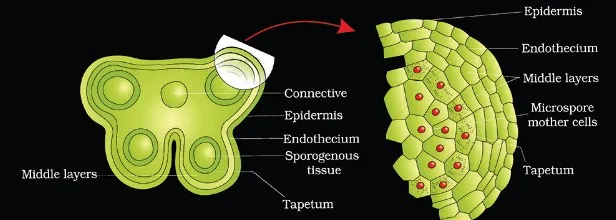
Microsporogenesis
Microsporogenesis is the process by which each sporogenous cell (microspore mother cell or pollen mother cell) divides meiotically to form microspore tetrads, with each cell in the sporogenous tissue capable of producing a microspore tetrad. Microspores form in a cluster of four cells known as the microspore tetrad.
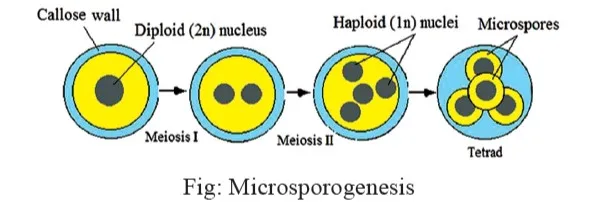
Pollen Development
The microspores separate from one another and form pollen grains as the anthers mature and dehydrate. Several thousands of microspores, or pollen grains, form inside each microsporangium and are released when the anther dehisces.
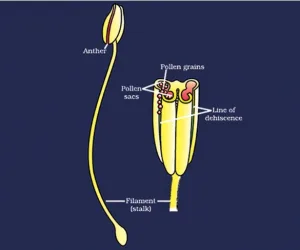
Development of Male Gametophyte
The development of the male gametophyte begins with the pollen grain, which is surrounded by a plasma membrane. When the pollen grain matures, it undergoes mitosis to produce two cells: the vegetative cell (large) and the generative cell (small).
- Vegetative Cell: The vegetative cell is larger, has abundant food reserves, and a large, irregularly shaped nucleus.
- Generative Cell: The generative cell is small, spindle-shaped, with dense cytoplasm and a nucleus.
In most angiosperms (over 60 percent), pollen grains are dispersed at the 2-celled stage when the generative cell is still undivided. However, in the remaining species, the generative cell undergoes mitosis to produce two male gametes before pollen shedding, resulting in a 3-celled stage. These mature pollen grains, either at the 2-cell or 3-cell stage, represent the male gametophyte.

Female Gamete Formation in Plants
The gynoecium is the female reproductive part of a flower. It can be either a single pistil (monocarpellary) or multiple pistils (multicarpellary). In multicarpellary gynoecium, the pistils may either be fused together (syncarpous) or free (apocarpous). Each pistil consists of three main parts:
- Stigma: This is the landing platform for pollen grains.
- Style: The style is an elongated slender part that connects the stigma to the ovary.
- Ovary: The ovary is the basal bulged part of the pistil that contains the ovules.
Inside the ovary is the ovarian cavity (locule), where the placenta is located. The placenta gives rise to the ovules, also known as megasporangia. The number of ovules in an ovary can vary from one (e.g., wheat, paddy, mango) to many (e.g., papaya, watermelon, orchids).
Megasporangium (Ovule)
The ovule is a small structure connected to the placenta by a funicle. The hilum is where the ovule and funicle fuse. A tiny aperture known as a micropyle can be found at the tip of each ovule, completely enclosed by one or more protective envelopes known as integuments.
Opposite the micropylar end is the chalaza, which represents the basal part of the ovule. Inside the integuments is the nucellus, a mass of cells containing reserve food materials. The female gametophyte or embryo sac is within the nucellus, typically formed from a single megaspore through meiosis.
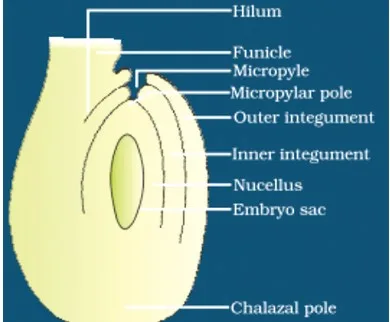
Megasporogenesis
Megasporogenesis is the formation of megaspores from the megaspore mother cell (MMC). Ovules generally differentiate a single megaspore mother cell in the micropylar region of the nucellus. The MMC undergoes meiotic division, resulting in the production of four megaspores.
Female Gametophyte (Embryo Sac)
In most flowering plants, one of the megaspores is functional while the other three degenerate. Gametophyte development begins with the functional megaspore. Monosporic development is the process by which an embryo sac forms from a single megaspore.
Formation of the Embryo Sac
The nucleus of the functional megaspore divides mitotically to form two nuclei, which move to opposite poles, forming a 2-nucleate embryo sac. The nuclei undergo further divisions to form 4-nucleate and 8-nucleate stages of the embryo sac.
These divisions are strictly free nuclear, meaning cell wall formation does not follow them immediately. After the 8-nucleate stage, cell walls form, forming the typical female gametophyte or embryo sac.
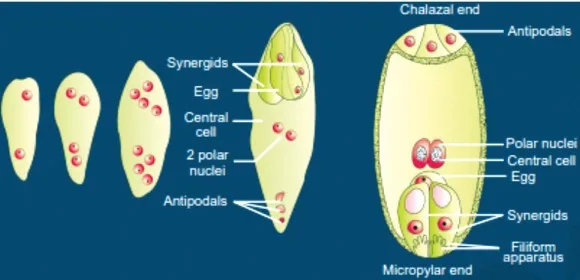
Cells Distribution Within the Embryo Sac
A mature embryo sac is typically 8-nucleate and 7-celled. Three cells—the egg apparatus—are grouped at the micropylar end. It comprises of:
- Two synergids
- One egg cell.
Synergids feature distinct cellular thickenings at their micropylar tip known as the filiform apparatus, aiding in directing pollen tubes towards the synergid. Two polar nuclei are found in the large central cell, and the three cells at the chalazal end are called antipodals.
Physics Wallah offers the NEET Online Coaching preparation. We offer affordable fees, experienced faculty, and a wide range of courses with live and recorded classes. Enroll Now!
| NEET Exam Important Links | |
|---|---|
| NEET Biology Syllabus | NEET Biology Diagrams |
| NEET Biology MCQ | NEET Biology Chapter wise Weightage |
| NEET Biology Notes | NEET Previous Year Question papers |
Pre Fertilisation FAQs
What is the difference between pre fertilisation and post-fertilisation events?
What is a pre fertilisation event?
What are the two main pre fertilisation events?
Is Syngamy a pre fertilisation event?










